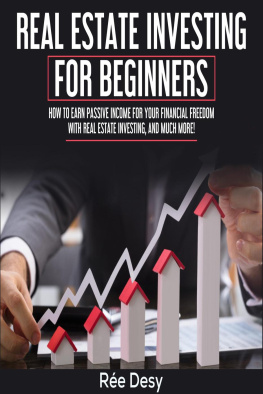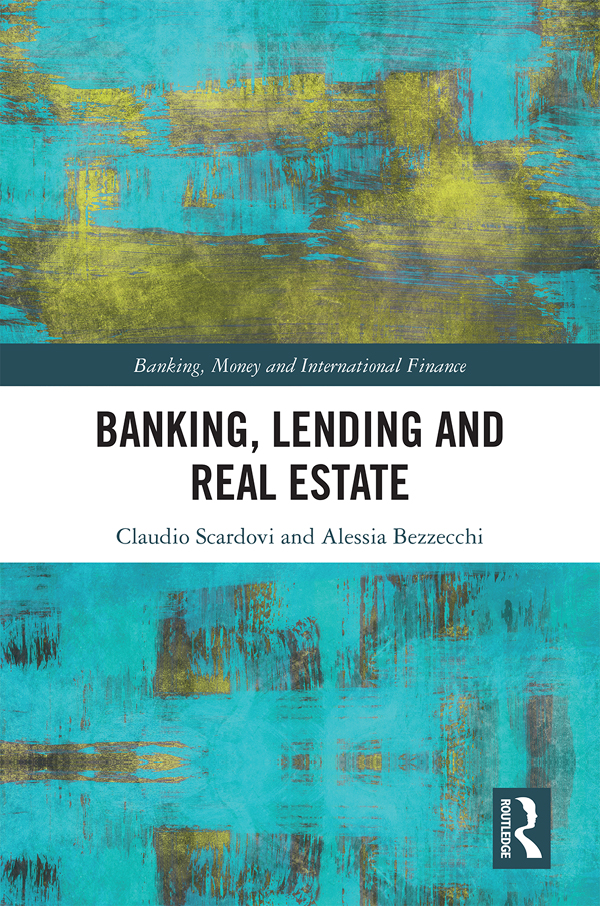Contents
Landmarks
Page-list
Banking, Lending and Real Estate
This book deals directly with the risk/return multiple trade-offs coming out of the closely intertwined relationship between banking and real estate. The authors explore how banks could embrace a more proactive approach to make the most of their, mostly long-only, exposure to real estate, and create positive spillover effects on their real estate counterparts and the sector as a whole. It provides a state-of-theart representation and analysis of the strategies that best practices in banking are adopting to manage these issues and plan for a new set of interrelations, driving a virtuous circle as opposed to the current one.
Banking, Lending and Real Estate is built on the academic know-how and professional expertise of the authors, who have been researching, writing and working on this joint topic for over a decade. With its pragmatic approach, it allows the reader to capture which leading hedge active and holistic approaches are available today and proven to treat, e.g., the banks overexposure to this asset class; to manage unlikely to pay and sub-performing positions; and to optimise the recovery value coming from the workout of real estaterelated NPL (and underlying assets). Case studies and relevant examples are provided, leveraging on the authors experience in consulting projects in the EMEA region and from working with global, regional and domestic banks and the real estate players acting across its value chain.
This book will appeal to both academics and business practitioners within the banking, financial services and real estate sectors, as well as professionals from financial and strategic/industrial advisory working in those fields.
Claudio Scardovi is a managing director and global co-head of the financial services practice for AlixPartners, a global consultancy focused on restructuring, value recovery, transformation and growth. Claudio has specialised in the financial services sector for the past 24 years, primarily (for 19 years) as managing director and country or regional head of financial services for a number of companies, including KPMG, Accenture, Intervaluenet.com, Oliver Wyman, Lehman Brothers, Nomura, Advent International and AlixPartners. He is also a professor at Bocconi University and at SDA Bocconi, specialising in capital markets, financial systems, restructuring and transformation, and for Imperial Colleges masters in management programme. Author of over 200 articles and papers and 17 books, Claudio is also one of the strategic advisors to the masters programme at Imperial College in London and is part of the strategic advisory board/Future of Banking for the World Economic Forum. He has also been a board member of Risanamento SpA and Consorzio AMI in Italy.
Alessia Bezzecchi is an Associate Professor of Practice di Corporate Finance and Real Estate and the Program Director of the Executive Masters in Finance (EMF), focused on asset/wealth management, corporate finance & control, banking transformation, and real estate transformation at SDA Bocconi School of Management. She is also teaching professor of capital markets at Bocconi University and director for the Executive Program in Real Estate Finance and Real Estate (EPFIRE).
Banking, Money and International Finance
9 Price and Financial Stability
Rethinking Financial Markets
David Harrison
10 A Comparative History of Bank Failures
From Medici to Barings
Sten Jnsson
11 Expert Systems in Finance
Smart Financial Applications in Big Data Environments
Edited by Noura Metawa, Mohamed Elhoseny, Aboul Ella Hassanien, M. Kabir Hassan
12 Equity Home Bias in International Finance
A Place-Attachment Perspective
Kavous Ardalan
13 Frontier Capital Markets and Investment Banking
Principles and Practice from Nigeria
Temitope W. Oshikoya and Kehinde Durosinmi-Etti
14 French Banking and Entrepreneurialism in China and Hong Kong
From the 1850s to 1980s
Hubert Bonin
15 Banking, Lending and Real Estate
Claudio Scardovi and Alessia Bezzecchi
For more information about this the series, please visit www.routledge.com/series/BMIF
Banking, Lending and Real Estate
Claudio Scardovi and Alessia Bezzecchi

First published 2019
by Routledge
2 Park Square, Milton Park, Abingdon, Oxon OX14 4RN
and by Routledge
52 Vanderbilt Avenue, New York, NY 10017
Routledge is an imprint of the Taylor & Francis Group, an informa business
2019 Claudio Scardovi and Alessia Bezzecchi
The right of Claudio Scardovi and Alessia Bezzecchi to be identified as authors of this work has been asserted by them in accordance with sections 77 and 78 of the Copyright, Designs and Patents Act 1988.
All rights reserved. No part of this book may be reprinted or reproduced or utilised in any form or by any electronic, mechanical, or other means, now known or hereafter invented, including photocopying and recording, or in any information storage or retrieval system, without permission in writing from the publishers.
Trademark notice: Product or corporate names may be trademarks or registered trademarks, and are used only for identification and explanation without intent to infringe.
British Library Cataloguing-in-Publication Data
A catalogue record for this book is available from the British Library
Library of Congress Cataloging-in-Publication Data
A catalog record has been requested for this book
ISBN: 978-0-367-23547-5 (hbk)
ISBN: 978-0-429-28030-6 (ebk)
Typeset in Times New Roman
by codeMantra
Claudio Scardovi and Alessia Bezzecchi
1.1 Intertwined destinies
Banking and real estate have always enjoyed a very close relation, apparently cosy but actually, most often, turning out to be built on shaky foundations (Scardovi and Bezzecchi 2014). Banks have developed their business model out of many intangible things. Intangible as, in fact, the money they manage as basis of their own commerce, as intangibles are the information advantages that have allowed to banks to profit from an easy intermediation game (buy the money sell the money make a hefty spread). And intangibility is the ultimate production factor of banking and of the financial services industry i.e. risk, be it of a financial or non-financial nature (e.g. pure risks like morbidity or mortality).
Risk is the ultimate production factor as banks originate, structure, underwrite, hedge, intermediate, insure, syndicate and sell a lot of it and of many different natures, most of them interconnected. The banks intermediation game (the basic buy the money sell the money) has developed also by stretching and leveraging risks. The bank has to manage the leverage inherently built into its money multiplier business model (on the back of 1 Euro of capital, it raises so many in liabilities that then it uses to extend loans to multiple counterparts), and it faces therefore a liquidity risk should a sudden withdrawal of its funds happen. It also faces a credit or market risk, as it starts to employ those funds to derive some yield, either by extending loans or by trading on the financial markets.











